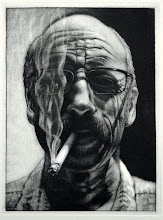The images below were selected for posting as they have utilized all of the processes we've explored to date. Intaglio is a tremendously versatile medium once the flexibility of its theories are explored and considered. Putting an acid resistant material on the surface of a metal plate and submerging it into acid can create all kinds of challenging effects. What are some acid resistant materials? We know asphaltum works, and soft ground, which is essentially a modified version of asphaltum that has a small dose of Vaseline. Other things that resist acid include crayons, sharpies, china markers, litho pencils, spray paint.... think about the fact that our acid solution is water-based, and then think about the things that don't mix with or dissolve in water. Think of the possibilities.
 Shawn's proof has a lot of movement around the central face that explores line, value, and texture, and given the face has such importance in the image, some kind of drastic process might be worthy of consideration, such as sand blasting the plate to a mezzotint surface and pushing a tonal layer on top of the etched layers by careful scraping and burnishing.
Shawn's proof has a lot of movement around the central face that explores line, value, and texture, and given the face has such importance in the image, some kind of drastic process might be worthy of consideration, such as sand blasting the plate to a mezzotint surface and pushing a tonal layer on top of the etched layers by careful scraping and burnishing. Hayley's proof has a strong graphic quality that may do some interesting things when combined with chine colle. Sounds like a demo....
Hayley's proof has a strong graphic quality that may do some interesting things when combined with chine colle. Sounds like a demo.... Chris's proof is developing some deep values and subtle imagery obfuscated by those deep values. Maybe some careful burnishing would help while maintaining the spontaneity of the image.
Chris's proof is developing some deep values and subtle imagery obfuscated by those deep values. Maybe some careful burnishing would help while maintaining the spontaneity of the image. Beth's plate has lots of levels, values, and textures that may print beautifully as a color separation. It may also be an interesting approach to actually cut into the plate edges to bring out some of the geometry.
Beth's plate has lots of levels, values, and textures that may print beautifully as a color separation. It may also be an interesting approach to actually cut into the plate edges to bring out some of the geometry. Adrienne's proof has some subtle soft ground passages and an effective progressive aquatint that she's now scraping and burnishing into, so that the value transitions are not so abrupt (a result of progressive aquatints). This image may also benefit from an application of Chine Colle.
Adrienne's proof has some subtle soft ground passages and an effective progressive aquatint that she's now scraping and burnishing into, so that the value transitions are not so abrupt (a result of progressive aquatints). This image may also benefit from an application of Chine Colle.We're moving further into the intaglio process and many of you have been able to get through our current state. The Labor Day Holiday, the water main break a week ago, my absence on Monday have set us back a little, but I think the progress is pretty close to where we want to be. Next week will be pretty full with Rob's Solar Plate demonstration, relief print demo, and some introductory color printing techniques.
Our intaglio plates have presented a wide variety of images, some suited to the process and some not so much so, but this first plate was to get experienced with many of the issues that present themselves in the course of etching and printing a metal plate. Some of the many examples are presented above. Each of these have gone through line etch, aquatint, and soft ground. Beth also explored open bite to some extent, and many have utilized scraping and burnishing. A few of the plates have enough levels within the plate that they'll be good candidates for some color experimentations.

1 comment:
I wouldn't mind sandblasting an area of the image, but I am not sure about doing anything drastic to the entire plate. This is my record, along with my journal of all the individual processes. I kept to my original composition, but I am not so worried about turning this into any kind of edition. This plate is my encyclopedia. I love the way Medusa is evolving on her own.
Post a Comment